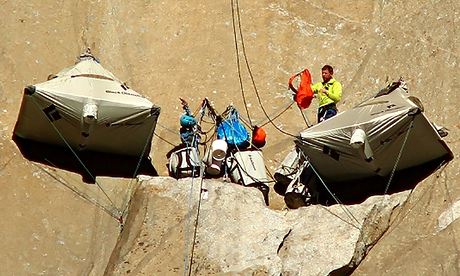
As Kevin Jorgeson, 30, and Tommy Caldwell, 36, approached the summit of El Capitan in Yosemite National Park last week, they were willed on not just by their friends and family but climbers around the world.
Their remarkable achievement, which saw them spend more than two weeks scaling a near-vertical 3,000ft rock face, was praised by Barack Obama and discussed by millions on social media. Now the pair hope their achievement will raise the profile of a sport already enjoying a surge in popularity before they became international celebrities. As Caldwell told the New York Times: “I would love for this to open people’s minds to what an amazing sport this is.”
His message seems to have already been heard in Britain, where climbing is enjoying a renaissance at both the grassroots and club levels. The latest Active People Survey suggests about 252,200 people over the age of 16 go climbing or hill walking at least once a month, while 79,500 take part at least once a week. The British Mountaineering Council has seen its membership increase from 25,000 in 1990 to more than 75,000 now. Almost a quarter of the council’s members are women. Some 300 clubs are affiliated to the BMC.
The building of indoor walls across the country, up from about 300 five years ago to 400 now, is being cited as the major factor in more Britons getting the climbing bug. Between them, the clubs receive some five million visits a year.
“When I started in the early 80s, there weren’t many climbing walls at all,” said Ben Moon, a former member of Britain’s climbing team. “Since the mid-90s they’ve taken off. I’d have died for the sorts of facilities they have these days.”
Mark English, general manager of Rock City, a climbing centre in Hull, said new walls were opening all the time. “We’re seeing the numbers of people go up as well as the frequency of visits,” he said. “There’s more emphasis on training these days. People want to excel at it.” The competitive streak starts young. The number of competitors in the BMC youth climbing series has risen by 50% in the past five years.
“Climbing is particularly attracting young adults,” English said. “The people who traditionally have the income to go to the gym. It’s replacing a lot of monotonous gym activity. It’s more challenging and there’s more of a mental element.”
The media have also played a part, English believes. The internet has introduced a new generation to what climbing can offer them. Television is also taking an interest. “Climbing long routes doesn’t work as a mainstream spectator sport, but the Bouldering World Cup has been getting a lot of attention on TV, and GB have been getting medals.”
Bouldering, once a niche form of climbing that is performed without the use of ropes or harnesses, is now the preferred option of many enthusiasts.
“A lot of new centres are boulder-only centres; they don’t even bother with the tall walls,” English said. “At centres like mine, demand is so high that we’re converting and extending a lot of space to deal with the growth in bouldering.”
Performed at a relatively low height above crash mats, many people are attracted to bouldering because it requires little equipment. “For bouldering, all you need is the rock shoes and the chalk dust to drive the sweat from your fingers, as well as a crash pad if you’re climbing outdoors,” said Paul Craven, UK sales agent at Moon Climbing, which has seen demand for its mats soar.
“Sales have probably quadrupled in the past 10 years, and the range of pads on sale has changed,” Craven said. “We do four different pads now, where we used to do just one or two. What used to be a generic product is now a fashionable item.”
However, Nick Colton, deputy CEO of the British Mountaineering Council, believes the fundamental reason climbing’s popularity is increasing is as much to do with the human psyche as it is with a desire to find new ways to keep healthy.
“When you climb, whether you’re on a wall or a mountain, you’re in your own little bubble,” he said. “You are focused only on your climb and everything else clears out. You do it for an hour and a half and when you’ve finished you’re refreshed in some way. It’s all about getting off the hamster wheel.”
Or as Caldwell described his climb up El Capitan: “It felt like a very spiritual experience the whole time.”

